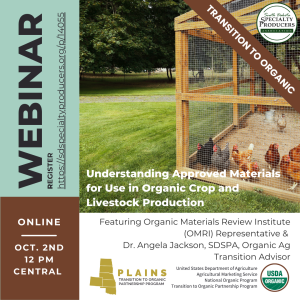Webinar to Discuss Approved Materials for Use in Organic Crop and Livestock Production and the Role of OMRI

Join SDSPA for this USDA TOPP (transition to organic) webinar on Oct. 2, 2024 at noon Central to understand approved materials for use in organic crop and livestock production. This training will feature Dr. Angela Jackson, SDSPA Organic Transition Ag Advisor for USDA TOPP Plains region and an expert from the Organic Materials Review Institute (OMRI).
This 65-minute webinar will provide an overview of the process for determining the use of materials approved for use in crop and livestock production under the USDA National Organic Program (NOP).
Participants will gain a clear understanding of the regulatory requirements, including how to identify and use approved substances to maintain compliance with NOP standards.
The webinar will also delve into the role of the OMRI in supporting the organic input industry. The role of OMRI’s certification process and its product lists will be explained.
By the end of the session, attendees will have the knowledge and resources needed to make more informed decisions about material use in organic farming, enhancing both their compliance and productivity.
Register HereThis program is supported through the United States Department of Agriculture (USDA) Transition to Organic Partnership Program (TOPP). TOPP is a program of the USDA Organic Transition Initiative and is administered by the USDA Agricultural Marketing Service (AMS) National Organic Program (NOP).
Agenda:
Welcome and Introduction
Understanding the NOP Standards for Approved Materials
- Overview of USDA National Organic Program (NOP) and its importance in organic farming
- Explanation of the NOP process for determining approved materials for crop and livestock production
- Key categories of approved materials (e.g., fertilizers, pesticides, livestock feed, and feed additives)
- How to identify and source NOP-compliant materials
Navigating the NOP National List of Allowed and Prohibited Substances
- Introduction to the National List: its purpose and structure
- Steps for determining if a material is allowed or prohibited under NOP standards
- Common challenges and solutions in selecting compliant materials
The Role of the Organic Materials Review Institute (OMRI)
- Overview of OMRI and its mission within the organic industry
- The OMRI listing process: how materials are evaluated and approved
- Benefits of using OMRI-listed products for organic producers
- How OMRI supports the organic input industry and helps maintain organic integrity
Practical Application and Case Studies
- Real-world examples of how organic producers utilize NOP-approved and OMRI-listed materials
- Best practices for ensuring compliance in organic crop and livestock production
- Q&A segment
Closing Remarks and Resources